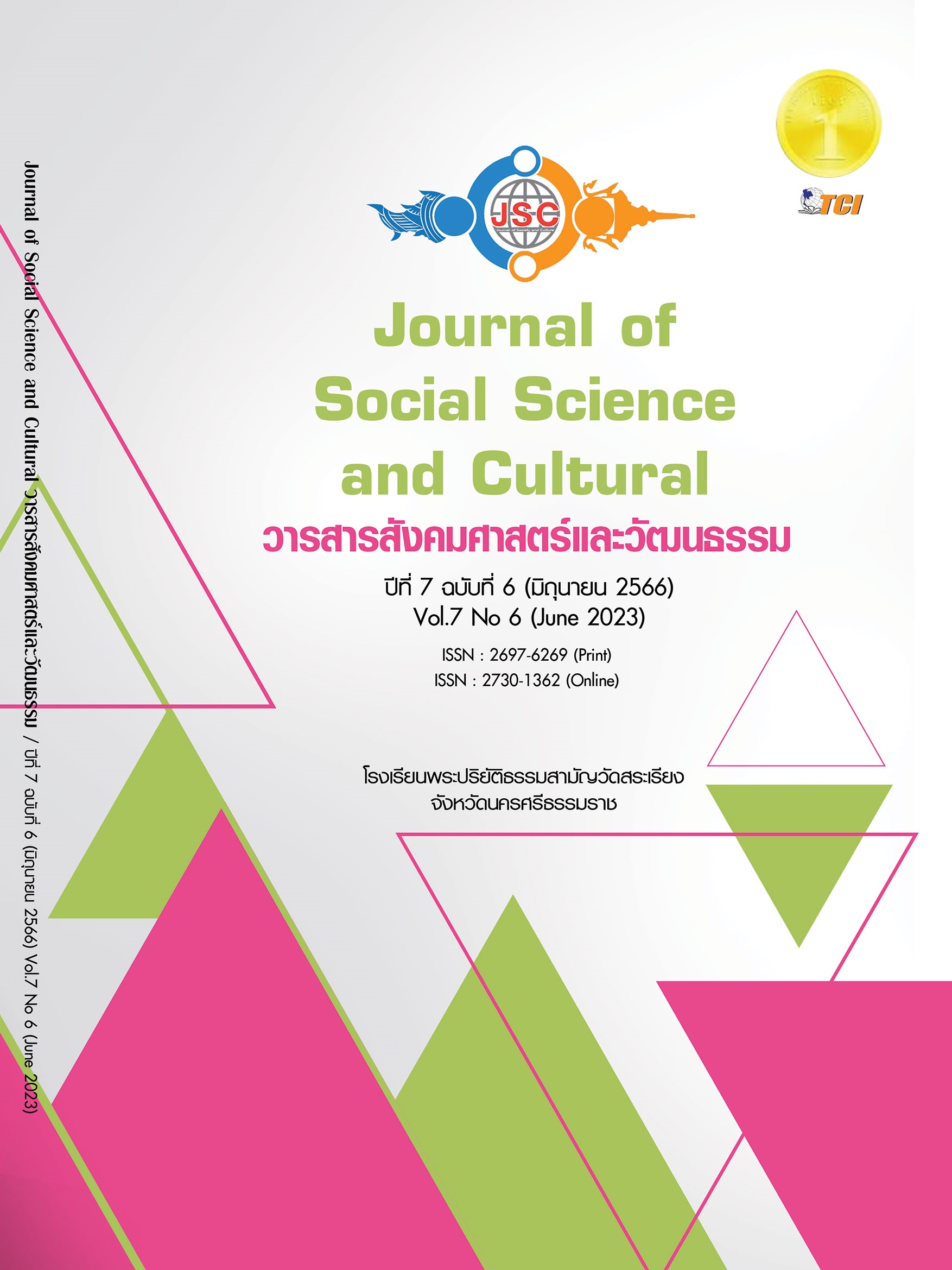ART THERAPY TO ENHANCE SOFT SKILLS FOR YOUTH WHO RECEIVED NON-FORMAL EDUCATION
Main Article Content
Abstract
The article purposed to 1) compare the soft skills’ mean values of the non-formal educated youth, which included three phases: before, between, and after joining the art therapy program, and 2) synthesize the soft skill development for the non-formal educated youth with the art therapy program. The research was a pre-experimental research design. The sample group was ten non-formal and informal educated youths between 15 to 18 years old and had the least scores in soft skill assessment. The research instrument consisted of 1) the soft skill assessment and 2) the art therapy program. The statistical analysis included mean and standard deviation and tested the hypothesis with repeated measure ANOVA, Pairwise comparisons, and descriptive data analysis. The research results indicated that 1) the comparisons of the soft skills’ mean values of the non-formal educated youth before, between, and after joining the art therapy program showed that the soft skills between and after joining the program were higher than before joining with the statistical difference at .01 level and the soft skills between and after joining the program increased with the statistical difference at .01 level and 2) synthesis of the soft skill development for the non-formal educated youth with the art therapy program illustrated that after joining the program, the youth had higher soft skills than before joining by developing eight attributives of soft skills which were self-awareness, flexibility, emotional management, positive thinking, empathy, sharing, responsibility, and honesty through the art therapy program which was designed to be appropriated with the youth’s capacities and had efficient results.
Article Details
References
กรมสุขภาพจิต. (2541). คู่มือการจัดกิจกรรมเพื่อเสริมสร้างทักษะชีวิตสำหรับเด็ก. นนทบุรี: สำนักพัฒนา สุขภาพจิต กรมสุขภาพจิต.
กานต์รวี ดาวเรือง. (2558). ทักษะชีวิตและการวางแผนการดำเนินชีวิตของเด็กและเยาวชน (ชาย) หลังจากออกจากศูนย์ฝึกและอบรมเด็กและเยาวชน. ใน วิทยานิพนธ์ปริญญามหาบัณฑิต สาขาวิชาการบริหารและนโยบายสวัสดิการสังคม. มหาวิทยาลัยธรรมศาสตร์.
คณะวิศวกรรมศาสตร์ มหาวิทยาลัยนเรศวร. (2561). การศึกษารูปแบบการพัฒนาทักษะชีวิตและความพร้อมในการประกอบอาชีพของเด็กและเยาวชนนอกระบบการศึกษาในจังหวัดเขตเศรษฐกิจพิเศษ. เรียกใช้เมื่อ 20 มีนาคม 2563 จาก https://www.dcy.go.th.pdf
คมกริช บุญพรม และประยุทธ ชูสอน. (2562). ตัวบ่งชี้ทักษะภาวะผู้นำด้าน SOFT SKILLS ของผู้บริหารสถานศึกษา ของโรงเรียนชายขอบ. วารสารการบริหารการศึกษาและภาวะผู้นำมหาวิทยาลัยราชภัฎสกลนคร, 7(26), 178-187.
ชดาพิมพ์ เผ่าสวัสดิ์ และคณะ. (2559). คู่มือการดูแลเด็กวัยเรียนที่มีปัญหาพฤติกรรม-อารมณ์ สำหรับบุคลากรสาธารณสุข (ฉบับทดลองใช้) (พิมพ์ครั้งที่ 2). กรุงเทพมหานคร: โรงพิมพ์ชุมชนสหกรณ์การเกษตรแห่งประเทศไทย จำกัด.
ชลิดา ชวนานนท์. (2552). ผลของกิจกรรมกลุ่มที่มีต่อทักษะทางสังคมของนักเรียนชั้นประถมศึกษาปีที่ 1 โรงเรียนสาธิตมหาวิทยาลัยราชภัฏนครราชสีมา. ใน วิทยานิพนธ์ปริญญามหาบัณฑิต สาขาจิตวิทยาการศึกษา. มหาวิทยาลัยราชภัฏนครราชสีมา.
ชโลธร โชติกีรติเวช. (2560). ความต้องการจำเป็นในการพัฒนาทักษะ Soft Skills เพื่อการจัดการเรียนรู้ของครู ในสถานศึกษาสังกัดสำนักงานเขตพื้นที่การศึกษามัธยมศึกษา เขต 25. วารสารวิจัย มข. (ฉบับบัณฑิตศึกษา) สาขามนุษยศาสตร์และสังคมศาสตร์, 5(1), 44-52.
ชูวิทย์ รัตนพลแสนย์, สุเทพ จันทน์เทศ และ พรพิชิต สุวรรณศิริ. (2554). ผลการใช้ศิลปกรรมบำบัดต่อ ภาวะซึมเศร้าของผู้สูงอายุในชมรมผู้สูงอายุ โรงพยาบาลในสมเด็จพระปิ่นเกล้า. วารสารวิทยาสารเกษตรศาสตร์ สาขาสังคมศาสตร์, 32(2), 191-200.
ฐาณรงค์ ทุเรียน. (2560). ผลการจัดการเรียนรู้พลศึกษาโดยใช้รูปแบบการเรียนรู้แบบร่วมมือที่มีต่อทักษะทางสังคมของนักเรียนมัธยมศึกษาตอนต้น. ใน วิทยานิพนธ์ปริญญามหาบัณฑิต สุขศึกษาและพลศึกษา. จุฬาลงกรณ์มหาวิทยาลัย.
ทวีศักดิ์ สิริรัตน์เรขา. (2550). ศิลปะบำบัดศาสตร์และศิลป์แห่งการบำบัด. เรียกใช้เมื่อ 10 พฤษภาคม 2563 จาก https://th.rajanukul.go.th/_admin/file-download/5- 4460-1448597095.pdf
ธีรากร มณีรัตน์. (2553). การพัฒนาทักษะทางสังคมสำหรับนักเรียนออทิสติกในโรงเรียนเรียนร่วมระดับประถมศึกษาโดยใช้เรื่องราวทางสังคม. ใน วิทยานิพนธ์ปริญญามหาบัณฑิต สาขาวิชาหลักสูตรและ การสอนการศึกษาพิเศษ. มหาวิทยาลัยขอนแก่น.
บุษกร วัฒนบุตร. (2564). ปัจจัยที่มีอิทธิพลต่อการพัฒนา Soft Skills ของเยาวชนไทยในศตวรรษที่ 21. วารสารวิจยวิชาการ, 4(1), 87-94.
ปริญญา เรืองทิพย์ และคณะ. (2561). การพัฒนาทักษะชีวิตด้านทักษะทางสังคมและอารมณ์ของนักศึกษาระดับอาชีวศึกษา. วารสารมหาจุฬานาครทรรศน์, 5(3), 706-729.
มนตรี ขุนอินทร์ทอง. (2561). ผลของศิลปะบำบัดแบบกลุ่มต่อความแข็งแกร่งในชีวิตของเยาวชนผู้เสพสารเสพติด. ใน วิทยานิพนธ์ปริญญามหาบัณฑิต สาขาวิชาการพยาบาลสุขภาพจิตและจิตเวช. มหาวิทยาลัยบูรพา.
มารุต พัฒผล. (2558). แนวคิดหลักการของการโค้ชเพื่อการรู้คิด. ใน เอกสารประกอบการเรียนรู้รายวิชาสัมมนานวัตกรรมโค้ชเพื่อการรู้คิด (เอกสารประกอบการสอน). มหาวิทยาลัยศรีนครินทร์วิโรฒ.
วิจารณ์ พานิช. (2555). วิถีสร้างการเรียนรู้เพื่อศิษย์ในศตวรรษที่ 21. กรุงเทพมหานคร: มูลนิธิสดศรีสฤษดิ์วงษ์.
ศศิธร ศักดิ์เทวินทร์. (2561). เข้าใจ จึงได้ใจ : เด็กไทยยุค 4.0. วาสารวิชาการหอสมุดแห่งชาติ, 6(1), 28-37.
สำนักงานกองทุนสนับสนุนการสร้างเสริมสุขภาพ. (2565). ศิลปะบำบัด ARTFIELD. เรียกใช้เมื่อ 1 พฤษภาคม 2565 จาก http://www.artculture4health.com/contents/view/3036
สำนักงานคณะกรรมการการอุดมศึกษา. (2561). ยุทธศาสตร์การพัฒนานิสิต นักศึกษาในสถาบันอุดมศึกษา (พ.ศ.2560-2564), 3-4. กรุงเทพมหานคร: สำนักงานคณะกรรมการอุดมศึกษา.
สำนักงานเลขาธิการสภาการศึกษา. (2561). สภาวะการศึกษาไทยปี 2559- 2560 และแนวทางการปฏิรูปการศึกษาไทยเพื่อก้าวสู่ยุค Thailand 4.0. กรุงเทพมหานคร: พริกหวานกราฟฟิค.
อภิวุฒิ พิมลแสงสุริยา. (2555). การพัฒนาพนักงาน. ใน จดหมายข่าวรายเดือนสถาบันเพิ่มผลผลิตแห่งชาติ. 13(149).
Glaittli, M. (2018). Soft Skills in High School [Doctoral dissertation, Arizona State University]. Retrieved March 20, 2020, from https://keep.lib.asu.edu/_flysystem/fedora/c7/205817/ Glaittli_asu_0010E_18354.pdf
Harris, B. M. (1963). Supervisory Behavior in Education. Englewood Cliffs, New Jersey: Prentice-Hall, Inc.
Liemann. (2004). Art Therapy for Groups: A Handbook of Themes and Exercises ("2" ^"nd" ed). New York: Brunner-Routledge Taylor & Francis Group.
OECD. (2018). Social and Emotional Skills Well-being, connectedness and success. Organization for Economic Co-operation and Development. In Research Report . Center for Education Research and Innovation.
Riggio, R. E. (1986). Assessment of basic social skills. Journal of Personality and Social Psychology, 51(3), 649–660.
Robles, M. M. (2012). Executive Perceptions of the Top 10 Soft Skills Needed in Today’s Workplace. Business Communication Quarterly, 75(4), 453-465.
Rongraung, Suravee., et al. (2014). Soft Skills for Private Basic Education School in Thailand. Social and Behavioral Sciences, 112(7), 956-961.
Rosal M. L. . (1996). Approaches to art therapy with children. Burlingame, CA: Abbey gate.
Szilárd, S., et al. (2018). Soft Skills Development Needs and Methods in Micro-Companies of ICT Sector. Social and Behavioral Sciences, 238(2018), 94-103.
Tang, K. N. (2020). The importance of soft skills acquisition by teachers in higher education insituations. Kasetsart Journal of Social Sciences, 41(1), 1-6.


